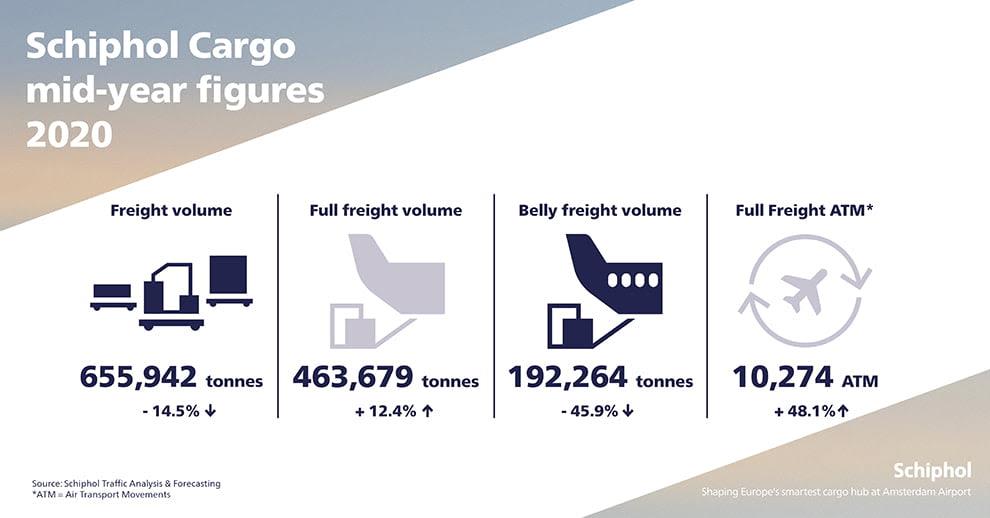Amsterdam Airport Schiphol (AAS) reported that total cargo volume for the first half of 2020 declined by 14.5% to 655,942 tonnes compared to 2019, as an increase in full freighter capacity did not make up for the decline in belly traffic.
Full freighter flights were up 48.1% to 10,274 Air Transport Movements (ATM) from January to June, but the number of belly flights dropped by 51.6% to 105,665 ATM compared to the first half-year of 2019.

In the first half of 2020, full freighter volume increased by 12.4% to 463,679 tonnes, while belly cargo volumes dropped 45.9% to 192,264 tonnes, due to belly ATMs decreasing 51.6% during the period.
Signs of recovery
AAS said inbound cargo volumes were down 11.5% to 341,130 tonnes and outbound cargo volumes were down 17.6% to 314,812 tonnes.
“Schiphol’s figures and operations were heavily impacted by the Covid-19 outbreak, and from early this year, the decline in passenger aircraft led to a decrease in belly volumes,” said Bart Pouwels, head of cargo, Amsterdam Airport Schiphol.
“ATMs are now showing signs of recovery which is positive. The extra belly capacity on intercontinental routes helps the air cargo market in Amsterdam to better serve its customers.”
Challenging markets
Every cargo market saw declines in the first half of the year as all regions were heavily impacted by the COVID-19 pandemic.
AAS said inbound cargo to North America was down 17.1%, in Europe, it dropped by 3% and Schiphol’s biggest market, Asia, saw declines, as inbound was down 8.1%, and outbound also declined by 17.5% although Shanghai remained as the biggest single market destination from January to June.
The airport noted that the Middle East region showed the only growth sector as inbound was up 9.2%.
Latin America market’s inbound volume fell 21.8% and inbound to Africa was down 29.5%.
Impact of COVID-19
Schiphol said it was affected by COVID-19 from early this year and it led to a steep decline in overall air traffic movements (ATMs) in the first six months of 2020.
At the lowest point in April, Schiphol was averaging about 144 ATMs per day every week, a 90% decline in ATMs in 2019.
“The COVID-19 pandemic has also led to a shift in cargo flows and some usually high-volume verticals have decreased such as the import and export of flowers,” said Pouwels.
Despite the challenges, Schiphol noted that it played a crucial role in transporting critical cargo in the fight against the virus such as personal protective equipment (PPE).
“The Schiphol air cargo community has worked closely together to ensure that essential cargo was moved through the supply chain,” said Pouwels.
Future outlook
The future is uncertain at Schiphol as markets around the globe are at different stages of the COVID-19 pandemic.
"We are seeing passenger flights increasing which means an increase in belly capacity, but it is important we move along with customer needs and make sure all demands are accommodated as well as possible,” said Maaike van der Windt, director aviation marketing, Cargo and Customer Experience, Amsterdam Airport Schiphol.
He noted that sustainability remains an important focus for Schiphol as air traffic picks up.



